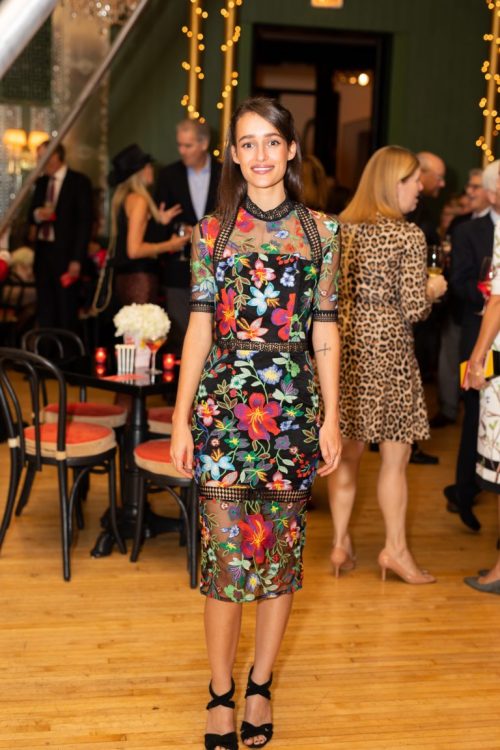
BY JUDY CARMACK BROSS
Trailblazing Chicago artist Josephine Bellini recently told us about creating a whole new art form based on cryptocurrency, a virtual currency designed as an alternative to traditional financial market. The world of digital assets could have no more articulate asset than Josie.
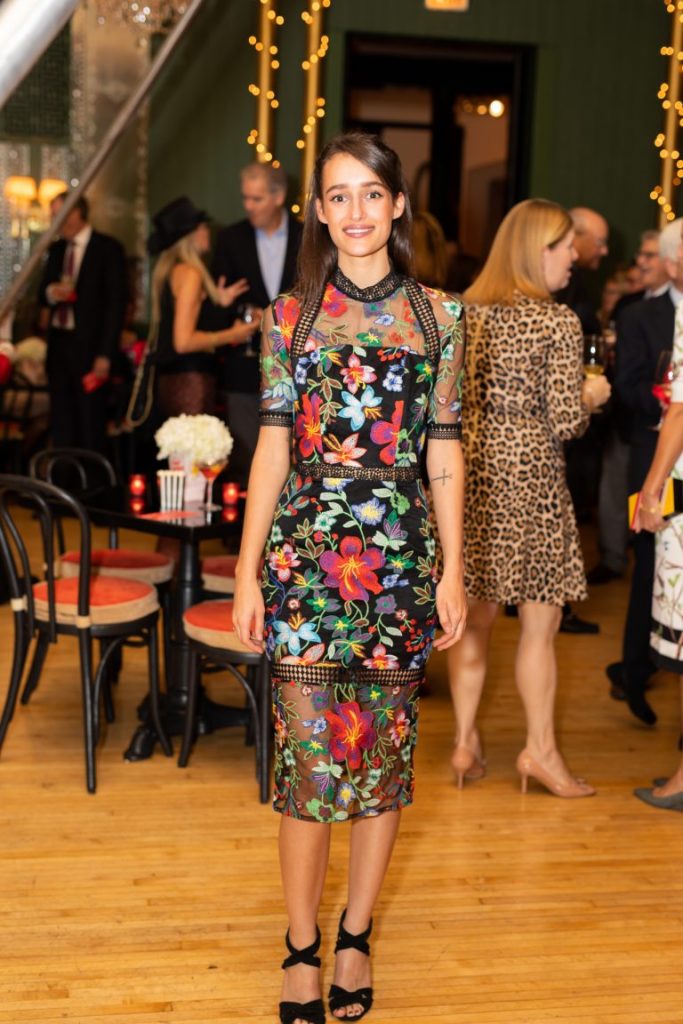
Josephine Bellini. Photo by Robin Subar.
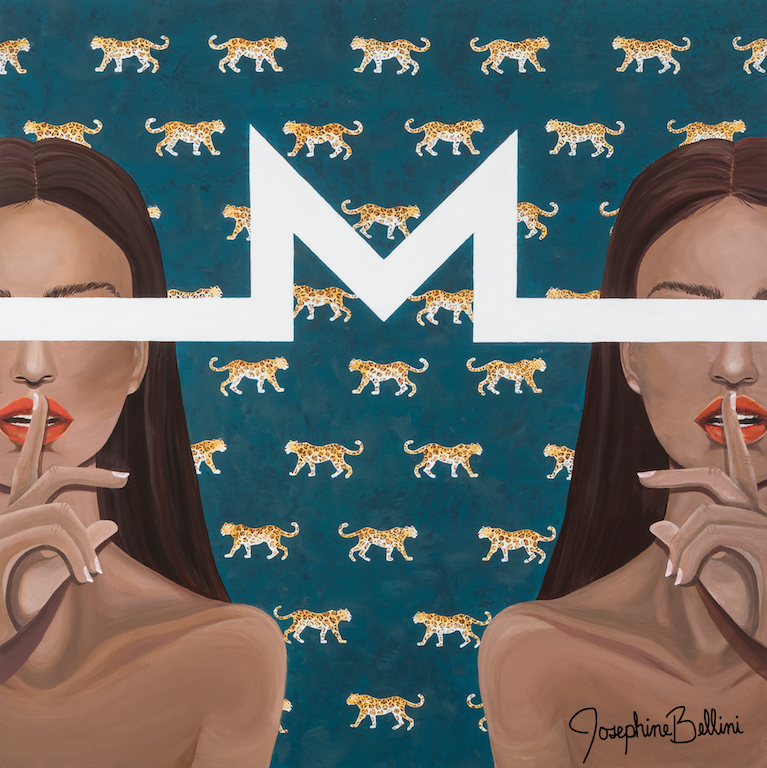
Thankful for Today.
Here’s what Josie shared about her work:
A piece of crypto-artwork just sold for $1 million but is a field that is so relatively unknown. Tell us about this industry.
Artists that focus on cryptocurrency as a subject matter are very limited. However, as the wider communities of cryptocurrency and blockchain—the underlying technology of cryptocurrencies—gain traction, we will see a substantial increase in the desire for art that conveys the core principles of our industry.
As to the broader cryptocurrency industry, it is an extremely nascent space that people liken to “the next internet.” I know that sounds like a promotional motto, but the underlying technology truly represents a paradigmatic shift in our current internet and financial systems. Because of this, the industry is filled with many people who are extraordinarily passionate about building—coding—our future. The core principles that drive this field are aimed at giving more power to the individual.
What inspired you to create artwork that focuses on cryptocurrency as a subject matter?
After learning about Bitcoin in 2013, I became intrigued, but it was not until early 2017 that I decided to really dig in. I learned about the technology, invested, and in November of 2017, I created my first artwork that related to the cryptocurrency ecosystem.
I choose to create cryptocurrency-focused artwork because I am very passionate about technology and think it can and will do incredible things. Also, the fact that there is a small (estimates are roughly only 50 million people in the world that own any cryptocurrency) and passionate population means that it is a great market for which to create art.
How does it feel to be on the forefront of a whole new art form?
It is incredible. Not only do I get a front row seat to this technological paradigm shift but also I feel like I am starting conversations through my work. I like to create art that brings attention to a situation in which cryptocurrency can have a positive influence. I also work on pieces about new technology created in the industry that are inspiring or innovative.
I love creating pieces that have a political vibe to stimulate conversation. My piece Filter is meant to stimulate the conversation about how the government has unlimited power to print more money, which devalues our purchasing power, so the subject dons a gas mask that has Bitcoin filters. This is meant to convey that ‘printing’ or creating more Bitcoin is not possible, thus in many ways more responsible.

Filter.
Have you been an artist all your life? As a child did you particularly enjoy art?
Although I was very creative when I was young, I took a long break during my college years and a couple years after. In 2017 I created my first piece of art in years and finally decided to listen to that instinct and continue.
Where do you create your artwork and where are you showing it?
I create all of my artwork at my apartment, which means there are stacks of canvases in place of a couch, table, and even chairs.
I show my work at crypto conferences, art shows, and across crypto specific social channels. Most recently I showed my art at a gallery in Paris to celebrate Bitcoin’s 10th birthday, but my largest presence is online. I post pictures of my pieces on crypto-specific forums and within online communities to grow my online fanbase.
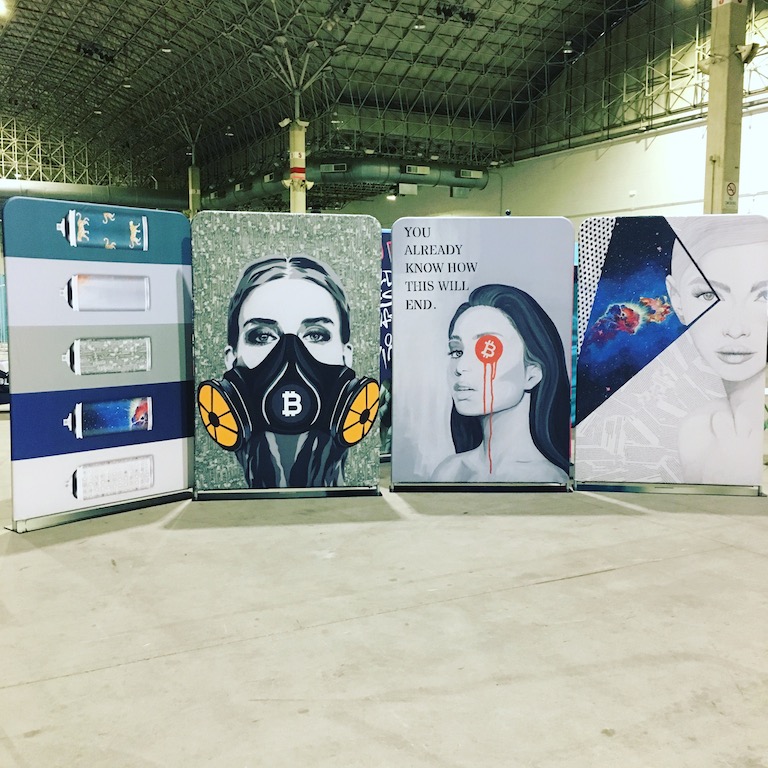
Josie’s work at the Art Chicago Conference.
Do you work with the same channel of creativity that one uses when painting? What style do you consider your artwork to be?
Yes! Often my artwork is mistaken for graphic art created by a computer, but I paint everything by hand (with the exception of recycled paper and money that I adhere to the background). My style combines portrait art and street art.
I like to have multiple mediums in each piece to tell different stories. Almost all of my works are a majority acrylic, but you can also find oil paint, spray paint, ripped currencies, recycled books and paper, inks, etc.
I start with a traditional pencil and paper sketches. Every piece begins with an idea that I have gathered from a news article, a new crypto project, the ups and downs of the market, or anything that is influencing me at that moment. After I transfer the sketch to a large-scale canvas, I begin painting my main subject and create her background afterwards. It’s hard for me to finish a piece in one sitting, so I often take breaks.
I am my own toughest critic, which makes it hard for me to love a piece at every stage in the process. Once I take a break from a piece, I don’t come back to it until I feel inspired again.
It is all meant to get people to think and reflect on different paths that this technology represents.
How does art relate to cryptocurrency?
I think my background in finance and tech helps me create art that has layers of meaning. Cryptocurrency technology is created with code and governed by mathematics. Code lacks human emotion and feeling, which is what makes it such a powerful and effective network. On the contrary, I wanted my art to bring these efficient machines to life.
I mostly use women as focal point of my art, which, from my view, balances the tech side of things. She draws you in to take another look, and then you begin to notice her surroundings. Some pieces have hundreds of dollars ripped up in the background, others have repeating powerful symbols. These repetitive images all have potent meaning. To me, what’s hidden is equally as important as what is visible.
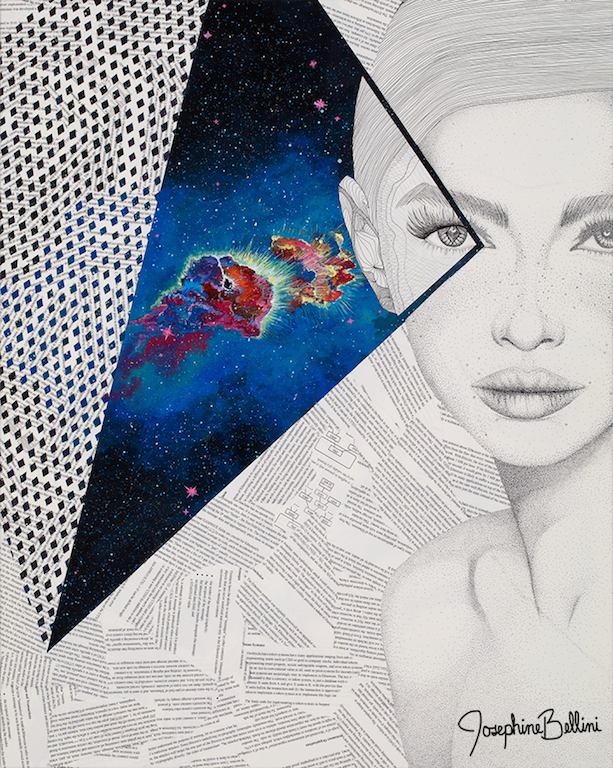
Nebula.
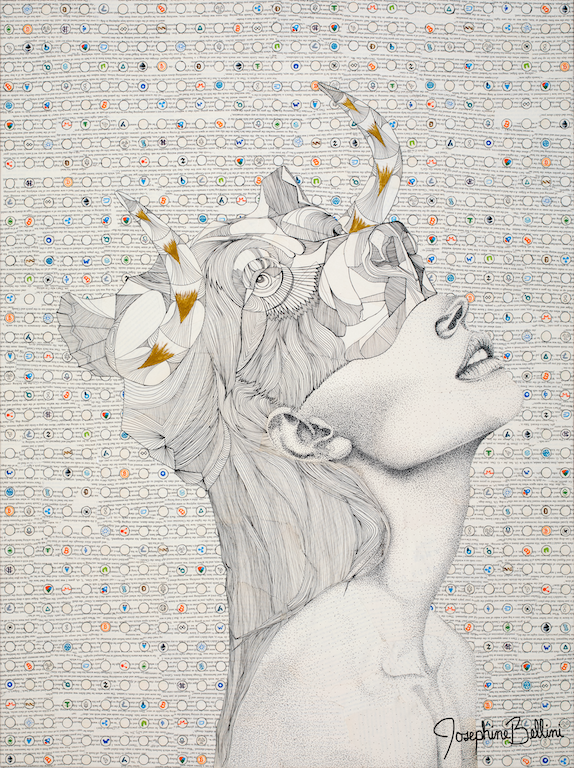
Genesis.
What would a typical workday look like for you?
I currently work a few days a week between two of the top cryptocurrency-related startups doing graphic design for them. I work closely with their teams to design websites, apps, and investor presentations. Collaborating with these projects keeps me on top of industry advancements and also allows me to have a personal relationship with leading people in the space. I am lucky enough to have the other four days a week to create art.
In what direction do you see your art heading?
I am positive that cryptocurrencies and blockchain-based applications will continue to grow in the future, but as it becomes more mainstream and widely adopted over the next 5-10 years, I am sure my art will evolve with it. I have only skimmed the surface of my thoughts about the world around me, but my next pieces really start to crystalize it.
I am pushing myself to think beyond the craft to the context of what I want to change within the world. If I can use art to spark a conversation about something more meaningful or help people become aware of the system and world around them, then I feel fulfilled in my work.
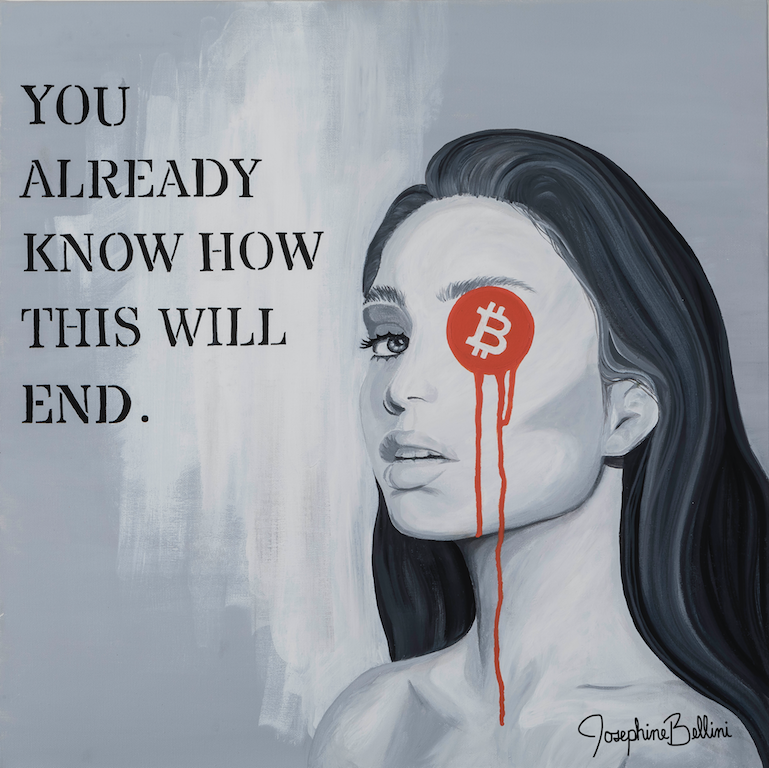
Acceptance.
What are you working on now, and what can we look forward to in the future?
I am in the middle of a few pieces right now, but the one I am most excited about is about the current situation in Venezuela. I recently met a young Venezuelan woman, Mariana, seeking political asylum in the United States, and I asked her if she would be interested in sharing her story.
As you might have heard, Venezuela is going through a massive financial crisis due to gross mismanagement of the economy by the president, Nicolas Maduro. In October of this year, the annual inflation rate went over 800,000%, which is staggering. The currency effectively became worthless while the price of everyday staples such as food, medicine, and rent skyrocketed out of reach for most people.
Then, in February of this year, the government launched its own cryptocurrency that is completely controlled by the government, which means it goes against the very core ethos of what Bitcoin and blockchain stand for—cryptocurrency should be governed by mathematics and code, not by people. The government is beginning to demand that people use the cryptocurrency to buy basic goods like gas. Venezuela used to be the richest economy in South America and now people are fleeing their homes to seek political asylum in other countries.
Mariana was extremely humble and had a positive mindset about her situation but also had deep compassion and love for her people and country. When I asked her if I could share some of her story through art, she felt that she hadn’t lived through anything compared to some of the people in her community. She felt fortunate for her opportunity to migrate, which only 7% of the country’s population has been able to do.
I am working on two pieces that share a small sliver of what is currently going on there. After discussing the current situation with Mariana, we agreed it would be important to donate all of the proceeds from the artwork directly to help Venezuelans still residing in-country.
She shared a story of a young woman from her town whose life was taken simply because she had a terrible allergic reaction to shellfish and was not able to access life-saving medicine at a local hospital. Mariana felt that donations from the artwork should be used to directly address the issue of Venezuelans who do not have access to proper medical care to prevent further devastation like the story shared above.
In addition to contributing money from the sale, I hope the piece helps promote awareness of the manipulation and injustices that are happening not only in Venezuela but globally. The artwork is something greater than a beautiful composition or interesting juxtaposition. Viewers will be able to connect with something universal, a human being or a story. My hope is that viewers will recognize the underlying message to look around, research, and take action.
***
For more information about Josie’s work, visit josie.io. To find her on Twitter, go to twitter.com/josiebellini, and on Instagram at instagram.com/josie.io.



